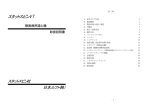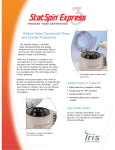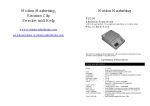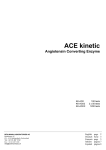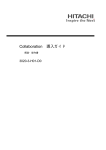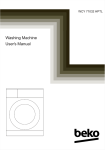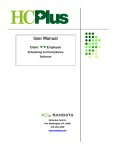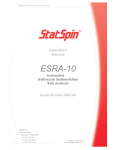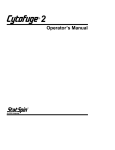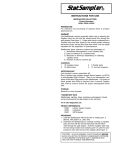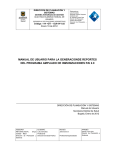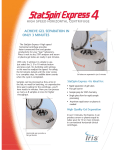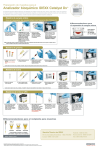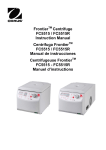Download CritSpin™
Transcript
CritSpin™ Operator's Manual Operator’s Manual for CritSpin Complete MicroHematocrit System For Model Number M960 Product Number CS02, CS12 CritSpin System with 120v, 60/50 Hz transformer CS02-10, CS12-10 CritSpin System with 100v, 60/50 Hz transformer CS12-22 CritSpin System with 220v, 60/50 Hz transformer Covered under one or more of the following U.S. patents: StatSpin and accessories: FlagTag Labels: StatSampler Tubes: #4,846,974 #4,981,585 #4,884,827 #5,257,984 Other patents applied for. CritSpin, LipoClear, SafeCrit, StatSampler and FlagTag are registered trademarks of StatSpin, Inc. Copyright 1998 Printed in U.S.A. StatSpin® Inc. 85 Morse Street Norwood, Massachusetts 02062 USA telephone toll-free telefax 781-551-0100 800-782-8774 781-551-0036 TABLE OF CONTENTS 1. 2. 3. 4. 5. INTRODUCTION & INTENDED USES 1.1 Introduction 1.2 Intended uses Microhematocrits 1 1 1 UNPACKING & INSTALLATION 2.1 Check for damage 2.2 Check for complete packaging 2.3 Installing the CritSpin 2.4 Power connection 2 2 3 3 SAFETY FEATURES & PRECAUTIONS 3.1 Symbols and definitions 3.2 Interlock mechanism 3.3 Manual latch 3.4 Opening & closing the cover 3.5 Precautions 3.6 Hazards 4 4 4 5 5 5 WORKING WITH CRITSPIN 4.1 Instructions for use 4.2 Appropriate use of rotors 6 7 CONTROLS & INDICATORS 5.1 Controls - “start “ button - “stop / open” button - “power” indicator 5.2 Indicators (audible) System Function Codes System Malfunction Codes 7 7 6. MAINTENANCE 6.1 Cleaning 6.2 Replacing an O-Ring 6.3 Checking the rotor speed 8 9 9 7. SPECIFICATIONS 9 8. SERVICE 10 9. DETERMINATION OF PACKED RED-CELL VOLUME or MICROHEMATOCRIT (Hct) 9.1 Procedure 9.2 Quality control 9.3 Normal values 9.4 Illustrations 11 13 13 14 REFERENCES 15 10. UNIVERSAL PRECAUTIONS Universal Precautions should be followed on all specimens, regardless of whether a specimen is known to contain an infectious agent. Universal Precautions have been stated by Center for Disease Control in 1987 and updated in 1988 and are reprinted in National Committee for Clinical Laboratory Standards proposed guidelines, “Protection of Laboratory Workers From Instrument Biohazards”. (see references) 1. INTRODUCTION & INTENDED USES 1.1 Introduction The CritSpin is a small, quiet, high-speed centrifuge. It employs a unique, proprietary drive and suspension system which results in nearly vibration-free operation. Light-weight, low-mass rotors achieve both top speed and full braking in a few seconds. The CritSpin instrument is designed to meet international safety standards. 1.2 Intended uses MICROHEMATOCRIT The CritSpin spins micro-capillary tubes for determining packed red cell volume (PCV) or hematocrits (Hct). Four types of microcapillary tubes are available: Microhematocrit Tubes Type Product Number Treatment Application HT9H HT9U Heparinized Untreated For finger-stick samples For anticoagulated samples HP8H HP8U Heparinized Untreated For finger-stick samples For anticoagulated samples Glass Plastic These tubes are easy to fill and require less than 20uL of blood. The tubes are spun in the 12-position Hematocrit Rotor (Product Number RH12). 1 2. UNPACKING & INSTALLATION 2.1 Check for damage sustained during transport The CritSpin and its accessories are delivered in one carton. If the apparatus or the accessories have suffered any damage in transport, please inform your carrier immediately. Save the shipping carton with all of its components in the event that the instrument needs to be returned for service. Please complete and return the Warranty Card. 2.2 Check for complete packaging CritSpin System comes packaged in one of two methods: Each of the main package contains: · One CritSpin Centrifuge · One wall transformer with cord or switching power supply · One Operator’s Manual with warranty card and extra O-rings · One Accessory carton containing: The accessory carton consists of: - One Hematocrit Rotor (RH12), with circular reader HR4C - Samples of various consumable products - see packing list CS02 & CS12 packaging differences: CS02 includes a second box which contains: · Illuminating Hematocrit Tube Reader · Wall transformer and cord · Instruction sheet OR CS12 includes within the accessory box: · Card-Type Slide Hematocrit Tube Reader (HR05) 2 2.3 Installing the CritSpin Place the CritSpin centrifuge on any surface acceptable for laboratory instrumentation. Position the CritSpin away from direct sunlight and sources of heat and cold. Mark a 300mm clearance boundary around the centrifuge to allow adequate ventilation and safety. The room temperature should be between 15oC and 32oC. When the centrifuge is cold, especially at a temperature below 10oC, the noise level will rise. 2.4 Power connection The transformer should be plugged into a grounded outlet with the voltage indicated on the label on the back of the transformer. The frequency (Hz) can be either 50 or 60 cycles. When power is connected 3 “beeps” will sound and the cover lock (see section 3.2 “Interlock Mechanism”) will be released and the instrument will be ready for use. To turn centrifuge off completely, disconnect power plug-in located at rear of the instrument. IMPORTANT: If the voltages do not match, do not connect the CritSpin to the power source. StatSpin Product No. 01-3553-001 01-3436-001 01-2535-001 Description MFG Model AC Power Adapter Centrifuge Power Supply APS AULT AD-740U-1240 SW105 AC Transformer StatSpin 21-1402-02 (Only for use with model M960-12) This CritSpin will give you very quiet, nearly vibration-free operation. To do this it utilizes a unique drive and motor suspension system. Plug in CritSpin and allow at least an hour to come to room temperature before running. After installation leave it plugged in unless not being used for a long period of time. 3 3. SAFETY FEATURES & PRECAUTIONS 3.1 Symbols and definitions Caution: Caution: Caution: Caution: 3.2 To reduce risk of injury - do not operate with an unbalanced load. Inspect rotors for fatigue. Incorrect tubes may damage rotor. To reduce risk of shock, do not disassemble. Refer servicing to qualified service personnel. There are no user serviceable parts. Interlock Mechanism The CritSpin incorporates an electrically operated lock mechanism which: 1. Prevents the centrifuge from being operated unless the cover is completely closed and latched. 2. Prevents the cover from being opened while the centrifuge is in operation. 3.3 Manual latch CritSpin Centrifuge is also equipped with a manually operated external latch which continues to hold the cover down after spinning is complete and the interlock mechanism has released. 4 3.4 Opening & closing the cover 1. When the cover is completely closed it is locked shut and an operating cycle can be selected. It can only be released if the “stop / open” button is pushed. 2. The cover is released at the end of the operating cycle or it can be released by pushing the “stop / open” button. The cover can then be opened by squeezing the black pieces of the latch together and lifting (see illustrations below). The cover of the CritSpin is usually left down, but not latched. In the event of a power failure while a sample is being processed, the automatic lock can be released manually. This is done by inserting the straightened end of a large paperclip or similar object into the small hole between the two buttons, in the front of the latch cover (facing the instrument) and manually pushing the lock lever inward. IMPORTANT: 3.5 Do not attempt to defeat the safety features of your CritSpin Centrifuge. Improper use of the equipment may impair the protection provided by the unit. Precautions The CritSpin is designed to prepare blood samples for diagnostic testing. Accordingly, use of the CritSpin places a responsibility upon administrative personnel to insure adequate training of operators as to the safe and effective use of the centrifuge. 3.6 Hazards The CritSpin is not explosion-proof and should not be used in a potentially explosive atmosphere. 5 4. WORKING WITH CRITSPIN 4.1 Instructions for centrifuge use IMPORTANT: For detailed hematocrit procedure, see Section 9. The CritSpin is normally left plugged-in and “on”. There is no “on-off” switch. 1. Lift the cover of the instrument and install the Hematocrit Rotor, RH12. Press rotor firmly in a downward motion onto the rotorholder of the CritSpin. Inserting the rotor The rotor bottom fits over a rubber O-ring on the rotor-holder. The Figure on the left shows a rotor, (cross-section) in place on the rotorholder. As the rotor turns, the Oring is moved outward by centrifugal force enhancing the frictional coupling between the rotor-holder and the rotor. Do not leave any rotor on the rotor-holder when the CritSpin is not in use for a long time. Doing so may compress the O-ring and decrease its ability to hold rotors. IMPORTANT: If a rotor is left in place and only the tubes are exchanged between runs, be certain to “bottom” the rotor on the rotorholder before spinning another sample. Failure to properly “seat” the rotor each time may result in the rotor becoming loose during centrifugation. 2. Close and latch the cover. 3. Press “start” button. (See section 6.0, “CONTROLS and INDICATORS”) 4. When the timed cycle is complete, the rotor will stop spinning. 5. The interlock mechanism will release and the black cover latch can be squeezed to open the cover. (see illustrations section 3.3) 6. The Hematocrit Rotor can then be removed and tubes read. See Section 10 for detailed instructions. 6 4.2 Appropriate use of rotors IMPORTANT: StatSpin Rotors are designed to be very lightweight to provide very quiet operation, compact size, and rapid processing. All such Rotors have a finite lifespan that is dependent upon usage. Rotors should be inspected for cracks and should be replaced immediately if any crack appears. 5. CONTROLS & INDICATORS 5.1 Controls The cycle of the CritSpin is preselected for 2 minutes. To initiate the cycle, install the Hematocrit Rotor, close and latch the cover and press the “start” button on the front panel. “start” button · initiates the 2 minute pre-timed cycle. “stop / open” button · interrupts the cycle and stops the centrifugation. The “stop / open” button is rarely used as the cycles are automatically timed. It can be used to release an accidentally latched cover. “power” indicator · green LED, illuminated when the CritSpin is connected to a power source. The CritSpin Centrifuge is not provided with an “on/off” switch. The centrifuge is normally left plugged in and “on”. The cover is usually left down but not latched. 5.2 Indicators (audible) System Function Codes · · Two medium beeps: Three short beeps: · Chirp: instrument ready, heard on power-up. cycle completed per specified operating parameters. start or stop command recognized by the microprocessor. 7 System Malfunction Codes One long beep followed by: · · · One short beep: Two short beeps: Four short beeps: · Five short beeps: rotor failed to reach rpm within 30 seconds. cover opened during operation. insufficient power to maintain rpm and/or use of incorrect rotor. over current detector tripped. 6. MAINTENANCE StatSpin Inc. has a Service Maintenance Program. Contact StatSpin’s Customer Service Department for details (In USA, dial toll free: 800-782-8774, or Phone: 781-551-0100, Fax: 781-551-0036). StatSpin recommends that instrument operators perform periodic inspections and preventative maintenance on all StatSpin instruments. This recommended protocol includes: 1.) Replace the O-Ring (see section 6.2). - only user serviceable part 2.) Contact the manufacturer customer service department if, at any time, the instrument is not functioning properly. (e.g. dislodging rotors, not cycling at full speed etc.) IMPORTANT: 6.1 Unplug the centrifuge before starting any maintenance work. Cleaning The outside surfaces and switch overlay panel can be cleaned with a water-dampened cloth and mild detergent. The inner surface or bowl, a powder-coated steel surface, can be cleaned with a mild detergent and disinfected if necessary by wiping with a cloth dampened with 70% alcohol or 10% bleach. IMPORTANT: DO NOT SPRAY the bowl or outer surfaces with detergent or bleach. Excess liquid will harm the electronics and subsequent problems will not be covered under warranty Do not use abrasives or solvents. The cover is made of scratchresistant polycarbonate and can be cleaned with mild detergent, glass or plastic cleaners on a soft cloth. 8 6.2 Replacing an O-ring The Figure on the left illustrates the position of the rubber O-ring which is attached to the rotor-holder. Should it ever break a new one can be installed as shown, by weaving it behind and in front of the 6 pins on the rotor-holder. The points at which the O-ring touches the rotor are indicated by the letter “A”. Extra O-rings have been included with this manual. 6.3 Checking the rotor speed The speed of the CritSpin Centrifuge should be checked by the user twice a year.11 The speed cannot be adjusted by the user. The rated speeds (+5%) can be checked with a photoelectric tachometer, available from many sources. If the CritSpin fails to achieve operating speed +5%, contact your distributor or StatSpin (800-782-8774) for service. 7. SPECIFICATIONS CritSpin Centrifuge: Power requirements Voltage: - nominal 100 V~ (range 90 to 110) - nominal 120 V~ (range 108 to 132) - Range 90 to 240 V Frequency - 50 or 60 Hz 9 7. SPECIFICATIONS (CONT.) Environmental Conditions: - Indoor use. - Altitude up to 2000m - Temperature 5ºC to 40ºC - Maximum relative humidity 80% for temperatures up to 31ºC decreasing linearly to 50% relative humidity at 40ºC. - Main supply voltage fluctuations not to exceed +/- 10% of the nominal voltage. - Transient overvoltages according to installation category II - Pollution degree 2 Timing - electronic, microprocessor controlled 1 fixed cycle of time and speed Maximum time to achieve operating speed Maximum time to stop rotation - 6 seconds 10 seconds Speed (rpm) Force (rcf) Time (sec.) 16,000 13,700 120 8. SERVICE With the exception of replacing the rotor-holder O-ring, there are no user-serviceable repairs. Refer to the Warranty for service instructions. Be sure to complete and return the Warranty as directed. Decontamination - Any machine or accessory containing accumulated blood and/or other chemical deposits must be cleaned prior to shipment to the manufacturer/dealer for service. This decontamination is required by Federal Law (Title 48 and 49 of the Code of Federal Regulations) and in accordance with the E.P.A.’s Regulations for Biohazard Waste Management. This decontamination cannot be performed by StatSpin personnel. Cleaning The outside surfaces and switch overlay panel can be cleaned with a water-dampened cloth and mild detergent. The inner surface or bowl, a powder-coated steel surface, can be cleaned with a mild detergent and disinfected if necessary by wiping with a cloth dampened with 70% alcohol or 10% bleach. 10 8. SERVICE (cont.) IMPORTANT: DO NOT SPRAY the bowl or outer surfaces with detergent or bleach. Excess liquid will harm the electronics and subsequent problems will not be covered under warranty Do not use abrasives or solvents. The cover is made of scratchresistant polycarbonate and can be cleaned with mild detergent, glass or plastic cleaners on a soft cloth. 9. DETERMINATION OF PACKED RED-CELL VOLUME OR MICROHEMATOCRIT (HCT) Both glass and plastic micro-capillary tubes are available. Product Number HT9H(glass) & HP8H(plastic) have been pretreated with ammonium heparin (may be color coded red) and should be used for capillary blood. They should be stored in a cool dry place. Product Number HT9U(glass) & HP8U(plastic) are untreated (may be color coded blue) and used for venipuncture (anticoagulated) samples. For glass tubes only: if the vial of tubes is new, unscrew the top, remove and discard the foam cushion and reattach the top. Now a single tube at a time can be shaken from the vial through the small hole in the center of the cover. 9.1 Procedure for packed red-cell volume (microhematocrit) 1A. Capillary (“fingerstick”) blood - prepare a skin site and lance. Use heparinized tubes, Product Number HT9H or HP8H. or 1B. Venous blood - take well-mixed anticoagulated blood from a syringe or a vacuum blood collection tube. Use untreated tubes, Product Number HT9U or HP8U. 2. Hold the micro-capillary tube by the end (may have colorcoded band). See Illustrations Section 11.4. 3. Fill to within 1mm of the end of the tube. Remove from sample. Turn capillary tube so dry end is ready for accepting the sealing compound. 4. Hold the tube in a horizontal position and push the dry (may have color-coded band) end of the tube fully into the vertically held sealing compound. Twist first and remove. 5. Using a laboratory tissue wipe off any blood that is forced from the other end. 11 9.1 Procedure for packed red-cell volume (cont.) 6. Put the tube, sealed end towards the outer rim, in any of the twelve positions on the Hematocrit Rotor, RH12. This rotor need not be balanced. Screw cover in place. 7. Holding the rotor by the black “cover knob”, attach the rotor to the rotor-holder. IMPORTANT: Always hold hematocrit rotor by the black knob on the rotor cover, when pressing it firmly in a downward motion onto the rotor-holder and when removing the rotor from the centrifuge. Pressing on the outer edges of the Hematocrit Rotor, RH12, may result in damage to the rotor. 8. Centrifuge the Hematocrit Rotor. 9. After the rotor stops, remove the rotor. To read hematocrit tubes either: For Product Number CS02, a.) Place the rotor into the middle of the illuminated, magnifying reader, HR6L. Follow the directions on it. For Product Number CS12, b.) Unscrew rotor cover. Remove tubes one at a time and place each on the card-type sliding reader, HR05. Follow the directions printed on it. Directions on both readers should be: “Position the reader so that the base of the red cells intersects the “0” (zero) line and the 100 percent line intersects the top of the plasma. Read the height of the red cell column directly from the scale. Interpolate between the markings to one percent.” Both Systems (CS02 & CS12) include a circular reader. This reader can be placed on top of the hematocrit rotor (RH12) after cycle is complete. The tubes are read without removing them from the rotor. Follow directions printed on it (stated above). 12 9.2 9.3 Quality Control 1. The Quality Control procedures established for your laboratory should be followed. 2. To verify the adequacy of cell packing, on a daily basis, select one or more tubes, (preferably with a hematocrit over 50), centrifuge and read. Spin these tubes a second time. The difference between the initial reading and the second reading should be 1 percent or less. Normal Values The following tables represent commonly accepted hematocrit values: Children Age Birth 14 - 90 days 6 months - 1 year 4 - 10 years % 44 - 64 35 - 49 30 - 40 31 - 43 Adults Gender Males Females Mean % 47 42 Range (2 s.d.) 40 - 54 37 - 47 Animals Species Canine Feline Equine Bovine Porcine Ovine % 37 - 55 24 - 45 32 - 52 32 - 38 32 - 50 24 - 45 13 9.4 Illustrations 14 10. REFERENCES 1. National Committee for Clinical Laboratory Standards. Proposed Guideline, Protection of Laboratory Workers from Instrument Biohazards, Document I 17-P, Vol. 11, No. 15, Appendix A, Pg. 61. 2. CDC.Recom m endationsforprevention ofHIV transm issionin health care settings.M M W R (Suppl.No.2S):2S-18S,1987. 3. CDC.Update:Universalprecautionsforprevention oftransm ission of hum anim m unodeficiencyvirus,hepatitisB virus and otherblood borne pathogensin health care settings.M M W R 37:377-387,1988. 4. NationalCom m itteeforClinicalLaboratoryStandards.Quantities andUnits:SI;Com m itteeReport.NCCLS PublicationC11-CR. NCCLS,Villanova,PA 1983. 5. NationalCom m itteeforClinicalLaboratoryStandards.Procedurefor Determ iningPackedCellVolum e bytheM icrohem atocritM ethod. ApprovedStandard.NCCLS PublicationH7-A.NCCLS,Villanova, PA,1985. 6. M iale,JB,LaboratoryM edicine:Hem atology,5th Edition,C.V.M osby Co.,St.Louis,1977 7. NationalCom m itteeforClinicalLaboratoryStandards.Procedures fortheCollection ofBlood by Venipuncture,2ndEdition;Approved Standard.NCCLS PublicationH3-A2.NCCLS,Villanova,PA,1984. 8. Fairbanks,VF,Nonequivalence ofAutom ated and M anualHem atocrit and ErythrocyticIndices,Am .J.Clin.Path. 73:55-62,1980. 9. M eites,S.,Pediatric ClinicalChem istry:3rd Edition,Am er.Assoc. forClin.Chem .,W ashington,DC.1989. 10. NationalCom m itteeforClinicalLaboratoryStandards.Collection, transport,and preparation ofblood specim ensforcoagulationtesting and perform ance ofcoagulation assays.PublicationNum berH21-A2. Villanova,PA.,19085,NCCLS,1991. 11. NationalCom m itteeforClinicalLaboratoryStandards.M olecular DiagnosticM ethodsforinfectiousDiseases;ApprovedStandard. NCCLS PublicationM M 3-A.NCCLS,Villanova,PA 1995. CS02-12-mc.pm5 1/8/98 55-001804-001 Rev. C Notes 85 Morse Street Norwood, Massachusetts 02062 USA telephone 781-551-0100 toll-free 800-782-8774 telefax 781-551-0036






















